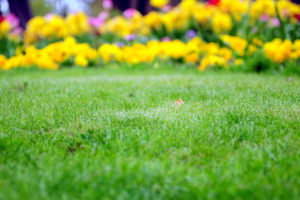
While there are general lawn care standards, Kentucky bluegrass has special care needs that should be considered if you have it for your lawn.
Kentucky bluegrass has always been and will always be popular, and we’re not talking about music (though there is nothing wrong with that either). No, this cool-season grass is one of the most common breeds of grass used in this country. Most of those beautiful, healthy lawns that you see and love are either all Kentucky bluegrass or a Kentucky bluegrass mixed with another cool-season grass. It is a good choice for cool zones and transition zones, but it does require a pretty significant amount of work. It is not an insurmountable amount of work, if you are really devoted to having a healthy Kentucky bluegrass lawn.
Mow Regularly
Kentucky bluegrass tends to have shallower roots, so letting it grow long is important (grass roots are proportional to blade height). For best results, you should be mowing your Kentucky bluegrass to about 2-3 inches each time. However, you don’t ever want to cut off more than a third of the blade at a time. This means that your Kentucky bluegrass should only get to about 4 inches tall before you mow – this can happen quickly, so for a really lush and healthy lawn, you’re going to be mowing very frequently.
Water Liberally
The great thing about cool season grasses is that they are fairly tolerant of both the cold winter and the heat of summer. In most cases, when summer brings drought conditions, Kentucky bluegrass will go dormant. This means that it gets brown and looks a little dead, but it is not (no need to order new sod yet). This process protects the plant from the scorching heat and drought. You can keep it green, however, by watering freely and often – sometimes over an inch of water a week. This will help it survive the summer heat without going dormant.
Fertilize Regularly
Kentucky bluegrass will look its best if you are regularly fertilizing it. For starters, leave the clippings on the grass when you mow – this is an instant nitrogen infusion as the clippings break down. Kentucky bluegrass loves nitrogen, so even with leaving the clippings, you should plan to fertilize 2-4 times each year, with one always being at the end of summer and beginning of fall to help the grass recover from summer stress. When you apply fertilizer in the spring, use a slow release type and wait till the grass is fully grown in and green before application.
Dethatch, Aerate, Weed
While leaving the clippings to help fertilize is good, if the thatch gets to be too thick (more than ½ inch) it will block air and water from reaching the soil and the roots of the plant. Using a core aeration machine to both aerate and dethatch at the same time is a good solution. Finally, don’t forget to weed as needed. The thicker and healthier your Kentucky bluegrass is, the fewer weeds you will encounter.
Have More Questions? Stay in Touch!
Order early and order often to ensure the best service possible. Contact us through our online page. Please find us at 27616 Little Lane, Salisbury, Maryland 21801. Our phone number is 410-726-6103, and our fax number is 410-742-6550. Speak to Jason Anderson for Turf Grass Sales. Reach him by email at jason@quanticocreeksod.com. Finally, follow us on social media on Facebook, LinkedIn, and our blog!
